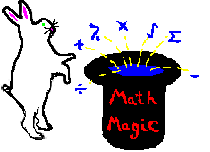

[ Home ] [ FOIL Method ] [ Double & Half Method ] [ Squaring Numbers ] [ Squaring Num End In 5 ] [ Squaring Num End In 6 ] [ Squaring Num End In 7 ] [ Squaring Num End In 8 ] [ Squaring Num End in 9 ] [ Squaring Nums 40-49 ] [ Squaring Nums 50-59 ] [ Squaring Nums 90-99 ] [ Difference of 2 Squares ] [ Mult Nums End in 5 ] [ Mult Nums One's Add 10 ] [ Mult Nums One's Add 5 ] [ Mult Nums Same Ten's Digits ] [ Mult Nums Tens Add 10 ] [ Mult Nums Less 100 ] [ Mult Nums More 100 ] [ Mult Nums More 100 Less 100 ] [ AB + BC ] [ AA + 2AA ] [ AA + 3AA ] [ AA + 7AA ] [ AA + 10AA ] [ Mult Nums Less 1000 ] [ Mult Nums More 1000 ] [ Add 2 Squares ] [ Product of 4 Nums ] [ Adding Consecutive Squares ] [ Squaring: 101a ] [ Adding Squares #2 ]
(*View/Download
.pdf file)
Multiplying Two Numbers Whose Tenís Digits Are The Same And Whose Oneís
Digits Add To 10:
A. From algebra we learn:
(10a + b) (10a +
(10-b)) = 100(a)(a + 1) + (b)(10 Ė b)
B. Using numbers instead of
variables we get the following rules:
1.
Multiply the oneís digits together.
Write this number down (make sure the number takes up 2 place values).
2.
Multiply the number in the tenís digit by that number plus 1.
Write the result.
Ex [1] 49 x 41 =_________.
a)
9 x 1 = 9. Write 09 to take
up 2 place values.
b)
4 x (4 + 1) = 4 x 5 = 20. Write
20.
c)
The answer is 2009.
Ex [2] 253 x 257 =_________.
a)
3 x 7 = 21. Write 21.
b)
25 x (25 + 1) = 25 x 26 = 650. Write 650. See Multiplying
by 25 or Double and Half.
c)
The answer is 65021.
Back to top

